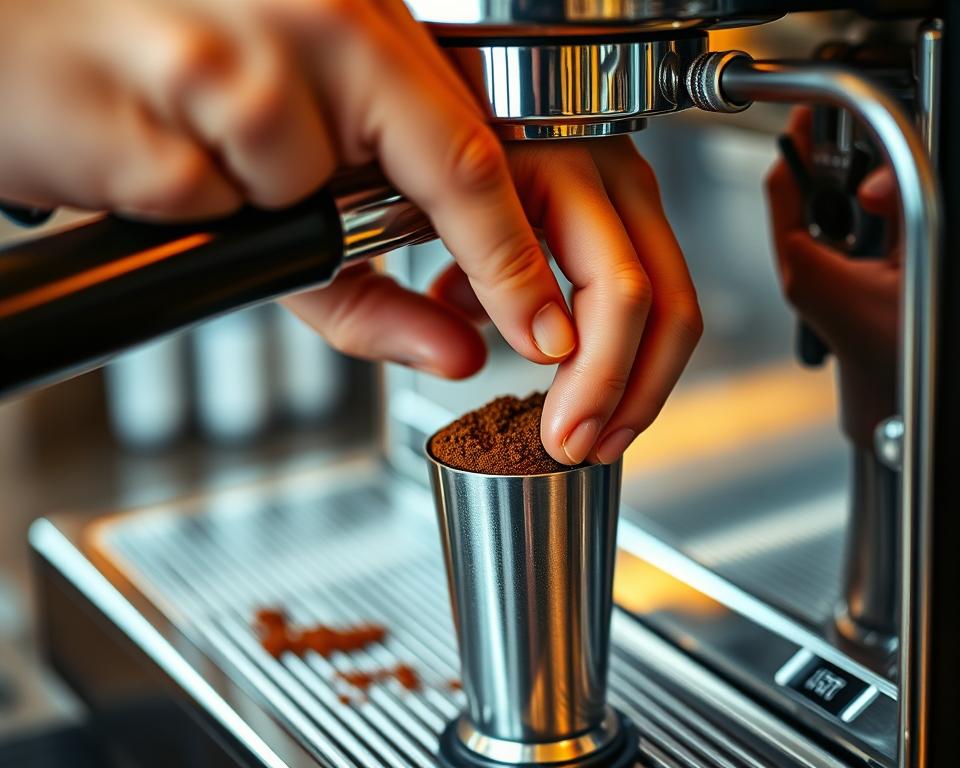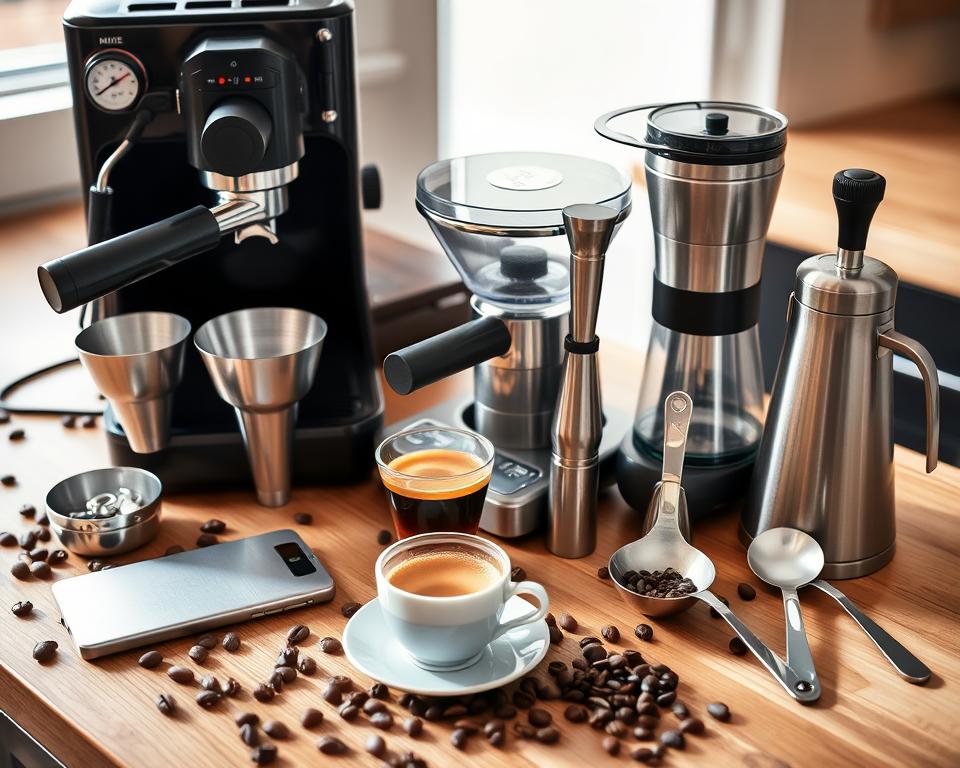Making espresso is an art that demands the right tools and techniques. With a quality espresso machine and premium coffee beans, anyone can craft a delightful espresso shot. Espresso machines operate at a pressure of about 150 psi. Modern machines use PID controllers to maintain brewing temperatures within ±1°F (0.5°C). This precision is key for a consistent brewing process.
Espresso is brewed with water at 90-95°C (194-203°F). The ideal brewing time is between 25 to 30 seconds. To perfect the shot, using the correct coffee amount is crucial. Double baskets need 16-18g of ground coffee. A good espresso machine and understanding brewing basics are essential for home espresso mastery.
High-quality coffee beans are vital for the perfect espresso. Freshly roasted coffee should be consumed within 3 – 7 days for the best flavor. The coffee bean type also impacts the espresso’s taste, with darker roasts needing a coarser grind and lighter roasts a finer one. By grasping these factors and honing techniques, anyone can brew the perfect espresso at home.
Key Takeaways
- Investing in a good espresso machine is crucial for making the perfect espresso at home.
- Using high-quality coffee beans is essential for achieving the best flavor.
- Understanding the basics of espresso brewing, including temperature and pressure, is vital for making the perfect shot.
- Practicing the right techniques, such as grinding and tamping, is necessary for achieving consistency and quality.
- Regularly tasting shots and adjusting techniques can help improve skills and achieve the optimal espresso.
- Making espresso requires patience and practice, with around 500 shot pulls needed to achieve a comfort zone and experience with a specific espresso machine.
Understanding Espresso Basics
Espresso is a unique and complex coffee drink that demands a deep understanding of its characteristics and brewing techniques. To excel in barista techniques, one must grasp the fundamentals of espresso. This includes its definition, history, and key differences from other coffee types. Such knowledge is crucial for achieving high-quality results and exploring various espresso recipes.
Understanding the importance of roast levels, brewing methods, and equipment is vital. Experts agree that espresso showcases the ultimate expression of roasted coffee. This highlights the need for a nuanced approach to its preparation. By mastering these concepts, individuals can develop the skills needed to create exceptional espresso drinks.
Exploring the world of espresso means delving into its distinct differences from other coffee types. It involves understanding the role of grind size, tamping, and brewing time in producing the perfect shot. By mastering these elements and experimenting with different espresso recipes, individuals can refine their barista techniques. This allows them to create unique, high-quality espresso drinks.
Essential Espresso Equipment
For brewing espresso, the right equipment is key. High-quality accessories can significantly improve flavor and consistency. Precision-grade espresso baskets, for example, are designed for optimal extraction.
Espresso makers come in two types: manual and automatic. Manual makers require effort and technique but can produce excellent espresso. Automatic makers are more convenient but still yield quality results. Coffee grinders, preferably burr grinders, are crucial for freshly grinding beans.
Espresso Makers: Manual vs. Automatic
Manual espresso makers, like lever-operated machines, demand user effort. This allows for precise control over brewing. Automatic makers, found in coffee shops, use pumps for consistent results. They are more convenient but less customizable.
Coffee Grinders: Burr vs. Blade
Coffee grinders are vital for fresh beans. Burr grinders are better than blade grinders for consistent grinds. Blade grinders can heat up, damaging beans. Popular burr grinders include the Baratza Encore ESP and the 1Zpresso J-Max.
Additional Tools: Tamper, Scale, and Pitcher
Other tools enhance the espresso experience. A tamper compresses coffee grounds for even extraction. A scale measures coffee and water accurately. A pitcher froths and steams milk. Fellow and Rhinocoffee are popular brands for these tools.
Choosing quality espresso accessories is crucial. Look for products designed for espresso brewing. With the right equipment, you can make espresso at home that rivals coffee shop quality. Investing in a good machine, grinder, and tools ensures perfect espresso every time.
| Equipment | Description | Price |
|---|---|---|
| Baratza Encore ESP | Burr grinder | $140.00 |
| 1Zpresso J-Max | Burr grinder | $199.00 |
| Fellow Precision Scale | Scale | $185.00 |
Choosing the Right Coffee Beans
For home espresso making, picking the right coffee beans is key to a perfect shot. With over 120 species of coffee, each with its own traits and taste, the choices can seem endless. Yet, for espresso, beans between 7-21 days off roast are best for the best crema.
Medium to darker roasted coffees are recommended for espresso due to their consistent taste. Darker coffees complement milk well, bringing out chocolate, caramel, and nut flavors. Favorites include Intelligentsia’s Black Cat Classic Espresso, Stumptown’s Hair Bender blend, and Counter Culture Coffee’s Big Trouble blend.
For those looking for unique tastes, small-batch, single-origin coffees offer an “adventure mode” in espresso. Traditional espresso blends have a darker roast, focusing on sweeter notes like dark chocolate and caramel. When picking coffee beans for home espresso, remember that most beans taste best within 2 weeks of roasting.
Here are some tips for selecting the perfect coffee beans:
- Look for beans that are between 7-21 days off roast
- Choose medium to darker roasted coffees for consistent flavor profiles
- Consider small-batch, single-origin coffees for unique flavors
- Check the roast date to ensure optimal flavor
By choosing the right coffee beans, you’re on your way to making delicious espresso shots at home. Always store your coffee beans correctly to keep their freshness and flavor.
Grinding Your Coffee
Grind size is key when brewing espresso. To get the perfect shot, your beans must be ground just right. Aim for a fine to medium-fine grind, which requires a burr grinder for consistency. For more on grinding for espresso, check out this website.
A burr grinder is vital for a consistent grind. Blade grinders, by contrast, can heat up the beans, ruining their flavor. Grind your beans immediately before brewing to preserve their taste and aroma.
Here are some tips for consistent grinding:
- Use a burr grinder to ensure a consistent grind size
- Grind your coffee beans just before brewing espresso
- Store your coffee beans in an airtight container to preserve freshness
By adhering to these guidelines, you’ll grind your coffee to the ideal consistency for espresso. This will enhance the beans’ flavor and aroma, leading to a delightful espresso shot.
| Grind Size | Description |
|---|---|
| Coarse | Used for French press or percolator |
| Medium | Used for drip coffee |
| Fine | Used for espresso |
Measuring Coffee and Water
To perfect your espresso, precise coffee and water measurement is key. The golden ratio, or coffee-to-water ratio, guides the ideal balance. A double espresso, for example, requires a 1:2 ratio, with 19 grams of coffee making 38 grams of espresso.
Using a scale for precision is essential. The Specialty Coffee Association suggests a 1:18 ratio as the Golden Cup Standard for many brewing methods. Yet, espresso brew ratios vary widely, from 1:1 to 1:4, depending on the shot type. For instance, a ristretto’s ratio is between 1:1 and 1:1.5, while a normale’s is between 1:2 and 1:3.
Understanding these ratios is crucial for crafting various espresso recipes. Adjusting the coffee-to-water ratio can greatly affect your espresso’s clarity and richness. For example, a strong brew ratio is 1:15, and a robust one is closer to 1:13. Exploring different ratios and methods can help you achieve your ideal flavor.
Some common brew ratios for espresso shots include:
- Ristretto shot: 1:1 to 1:1.5
- Traditional espresso: 1:2 to 1:2.5
- Lungo (long shot): approximately 1:3
Mastering coffee and water measurement opens up a world of delicious espresso recipes and brewing methods. It elevates your coffee experience to new heights.
The Art of Tamping
Mastering the art of tamping is crucial for achieving the perfect espresso shot. Proper tamping techniques ensure that the coffee grounds are evenly compacted, allowing for optimal flavor extraction. Barista techniques emphasize the importance of using the right amount of pressure to compact the coffee grounds.
A key factor in tamping is the amount of coffee grounds used. The recommended amount for a single shot of espresso is 7-9 grams, while a double shot requires 14-18 grams. Using the right amount of coffee grounds and applying the correct tamping pressure can make a significant difference in the quality of the espresso.
Proper Tamping Techniques
To achieve the perfect tamp, it’s essential to use the right technique. A 90-degree elbow angle is suggested for optimal tamping posture. The tamping pressure should be firm but not excessive, allowing water to flow through the espresso grounds gradually. Espresso accessories, such as convex-curved tampers, can help improve edge sealing of the puck in the filter basket.
Here are some tips for proper tamping:
- Use the right amount of coffee grounds
- Apply the correct tamping pressure
- Use a 90-degree elbow angle for optimal tamping posture
- Choose the right espresso accessories, such as a convex-curved tamper

Common Tamping Mistakes to Avoid
Uneven tamping can cause up to a 30% variation in extraction quality, leading to imbalanced flavor profiles. Overfilling the portafilter can result in an over-brewed espresso, while underfilling can lead to under-extraction. By following proper tamping techniques and using the right espresso accessories, you can avoid these common mistakes and achieve the perfect espresso shot.
| Tamping Pressure | Espresso Quality |
|---|---|
| Too little pressure | Under-extraction |
| Too much pressure | Over-extraction |
| Optimal pressure | Perfect espresso |
Brewing Your Espresso
Understanding the process of brewing espresso is key to perfecting your shots. It involves forcing hot water through finely ground coffee beans. This results in a concentrated beverage with a rich flavor and aroma. Home espresso making requires attention to detail, including temperature and pressure guidelines, to ensure optimal flavor and consistency.
Temperature is crucial, with ideal temperatures ranging from 194 to 205°F, depending on the coffee beans’ roast level. Pressure is also critical, with a typical brewing pressure of around 9 atmospheres. The brewing process typically takes 20-30 seconds, resulting in a shot of espresso with a thick, creamy texture and a distinctive flavor.
In home espresso making, understanding brew ratios is essential. Brew ratios refer to the amount of coffee grounds used versus the final extraction yield or liquid in your cup. A typical brew ratio for espresso is around 1:2 to 1:3, with 18 grams of coffee yielding 36 grams of liquid. By mastering the art of brewing espresso, you can enjoy a perfect shot every time, with a rich flavor and aroma that’s sure to satisfy your coffee cravings.
Temperature and Pressure Guidelines
For optimal flavor and consistency, it’s essential to follow temperature and pressure guidelines when brewing espresso. The ideal temperature for brewing espresso depends on the roast level of the coffee beans, with lighter roasts requiring higher temperatures and darker roasts requiring lower temperatures.
Timing the Extraction Process
Timing is everything when it comes to brewing espresso, with the extraction process typically taking around 20-30 seconds. The goal is to achieve a balanced extraction, with the perfect amount of flavor and aroma in the final shot. By mastering the art of brewing espresso, you can enjoy a perfect shot every time, with a rich flavor and aroma that’s sure to satisfy your coffee cravings.
Troubleshooting Common Espresso Issues
Perfecting the espresso shot involves several key factors. Even with the right gear and methods, problems can still occur. Over-extraction often results in bitterness, while under-extraction can make the espresso sour.
Understanding the ideal brewing parameters is crucial. A double espresso typically uses 19 grams of coffee, with an extraction time of 30-35 seconds. Too long, and it’s bitter; too short, and it’s sour.
The brew water’s temperature is also vital. Water that’s too hot can burn the coffee, leading to bitterness. The ideal temperature is between 92°C and 96°C. Adjusting temperature and extraction time can balance your espresso, regardless of the brewing method.
Common issues and their fixes include:
- Harsh or bitter taste: adjust the grind setting or reduce the extraction time
- Sour taste: increase the extraction time or adjust the temperature
- Thin or blonde shot: check the grind setting and adjust as needed
By grasping the causes of these issues and tweaking your brewing methods, you can refine your technique. This ensures a delightful espresso shot every time.
Enhancing Your Espresso Experience
To elevate your espresso, explore espresso recipes and quality espresso accessories. Try different roast levels, unique flavors, and invest in a good grinder or scale. This will help refine your brewing and make the experience more enjoyable.
Mastery in milk frothing is crucial for enhancing your espresso. It involves achieving the perfect temperature and texture for steamed milk. With practice, you can create velvety-smooth milk to complement your espresso.
Exploring Flavor Additions and Syrups
Experimenting with flavor additions and syrups can also elevate your espresso recipes. Try flavored syrups like vanilla or hazelnut, or add cream or sugar. This way, you can find the perfect flavor combination that suits your taste and enhances your espresso experience.

Consider investing in espresso accessories like precision baskets, coffee distribution tools, and scale-equipped grinders. These tools can help you perfect your brewing technique. By using these accessories and honing your skills, you can enjoy a more satisfying and delicious espresso.
Cleaning Your Espresso Equipment
Regular cleaning of your espresso machine is crucial for its optimal performance and flavor. Daily maintenance includes brushing the machine after each use and backflushing with Urnex Cafiza Tablets weekly. This prevents coffee residue and scale build-up, which can block water lines and cause expensive repairs.
For those who make espresso at home, thorough cleaning is advised once a week or at least monthly, based on usage. Professional cleaning can cost up to a couple hundred dollars. Regular maintenance is more cost-effective and ensures the machine works well and produces great espresso.
Some essential cleaning tasks include:
- Scrubbing the machine with a brush after each use
- Backflushing with Urnex Cafiza Tablets once a week
- Soaking the portafilter and components in a cleaning solution for 20 minutes
- Cleaning the steam wand by soaking it overnight in water
Regular cleaning is vital for maintaining the flavor and quality of your espresso. Coffee experts stress that “good filtered water is absolutely crucial to great espresso.” By sticking to a cleaning routine, you can ensure your espresso machine continues to produce excellent shots.
By adding these cleaning tasks to your home espresso making routine, you can enjoy better-tasting espresso and extend your machine’s life. It’s important to use espresso machine-specific coffee detergents. Avoid vinegar, as it can harm the machine’s life and flavor of espresso shots.
Storing Your Coffee Beans
Keeping your coffee beans fresh requires proper storage. Since they are hygroscopic, they can absorb moisture from the air. This makes refrigerator storage a bad idea. Instead, store them in an airtight container in a cool, dark spot.
Minimizing air movement and light exposure is crucial for preserving flavor and aroma. Freezing is an option, but break larger bags into two-week portions for best freshness.
Best Practices for Freshness
Experts suggest vacuum sealing coffee portions for longer freshness. The FoodSaver VS3150 is a recommended system. Resealable coffee bags with valves also help, allowing CO2 to escape while keeping oxygen out.
Other tips for storing coffee beans include:
- Buying smaller quantities more often to improve flavor and freshness
- Keeping coffee in a cool, dark place to avoid light and heat
- Using a grinder with an airtight hopper to prevent staleness
By following these guidelines, you can maintain your coffee beans’ freshness and flavor. Whether for espresso or other coffee types, proper storage is key. With the right storage and accessories, every cup will be perfect.
Enjoying Your Espresso
Now that you’ve mastered the art of crafting the perfect espresso at home, it’s time to sit back, relax, and savor the fruits of your labor. From classic espresso shots to creative espresso brewing methods, the possibilities for enjoying your homemade espresso are endless.
Begin by experimenting with different espresso-based drinks, such as the smooth and velvety espresso macchiato or the robust and balanced cortado. Explore the nuances of each preparation, noting how the ratio of espresso to milk affects the overall flavor and texture. For a refreshing twist, try an espresso tonic or an indulgent espresso martini, both of which showcase the versatility of this beloved coffee.
As you sip your expertly brewed espresso, take the time to appreciate the intricate flavor profile. Pay attention to the notes of dark chocolate, caramel, or even subtle fruity undertones, depending on the coffee beans and roast level you’ve chosen. Pairing your espresso with a crisp biscotti or a square of rich dark chocolate can further enhance the drinking experience.
Remember, the joy of enjoying espresso is not just about the final product, but the journey of perfecting your technique. With each cup, you’ll discover new ways to refine your skills and uncover the true potential of this beloved coffee. So savor every sip, share your creations with friends, and continue to explore the endless possibilities of the espresso world.
FAQ
What is the difference between espresso and other coffee types?
What are the essential pieces of equipment needed to make espresso at home?
How do I choose the best coffee beans for espresso?
What is the ideal grind size for espresso?
How do I properly tamp the coffee for espresso?
What is the ideal brew ratio for espresso?
How can I troubleshoot common espresso issues, such as bitterness or sourness?
How do I properly clean and maintain my espresso equipment?
How should I store my coffee beans to maintain freshness?
What are some tips for enhancing the espresso experience?

Tina Avila is a writer at WyNeeds, where she delves into the rich and diverse world of coffee. With a passion for flavors and brewing techniques, she brings insightful articles covering everything from coffee culture and bean origins to expert tips on making the perfect cup. Her goal is to inspire and educate coffee enthusiasts, helping them enhance their appreciation for every sip.

